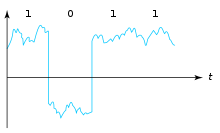
Back إشارة رقمية Arabic Rəqəmsal siqnal Azerbaijani Лічбавы сігнал Byelorussian Цифров сигнал Bulgarian Senyal digital Catalan سیگناڵی دیجیتاڵ CKB Цифрăлла сигнал CV Digitalsignal German Ψηφιακό σήμα Greek Señal digital Spanish

A digital signal is a signal that represents data as a sequence of discrete values; at any given time it can only take on, at most, one of a finite number of values.[1][2][3] This contrasts with an analog signal, which represents continuous values; at any given time it represents a real number within a continuous range of values.
Simple digital signals represent information in discrete bands of analog levels. All levels within a band of values represent the same information state.[1] In most digital circuits, the signal can have two possible valid values; this is called a binary signal or logic signal.[4] They are represented by two voltage bands: one near a reference value (typically termed as ground or zero volts), and the other a value near the supply voltage. These correspond to the two values "zero" and "one" (or "false" and "true") of the Boolean domain, so at any given time a binary signal represents one binary digit (bit). Because of this discretization, relatively small changes to the analog signal levels do not leave the discrete envelope, and as a result are ignored by signal state sensing circuitry. As a result, digital signals have noise immunity; electronic noise, provided it is not too great, will not affect digital circuits, whereas noise always degrades the operation of analog signals to some degree.[5]
Digital signals having more than two states are occasionally used; circuitry using such signals is called multivalued logic. For example, signals that can assume three possible states are called three-valued logic.
In a digital signal, the physical quantity representing the information may be a variable electric current or voltage, the intensity, phase or polarization of an optical or other electromagnetic field, acoustic pressure, the magnetization of a magnetic storage media, etcetera. Digital signals are used in all digital electronics, notably computing equipment and data transmission.

- ^ a b Robert K. Dueck (2005). Digital Design with CPLD Applications and VHDL. Thomson/Delmar Learning. ISBN 1401840302. Archived from the original on 2017-12-17. Retrieved 2017-08-30.
A digital representation can have only specific discrete values
- ^ Proakis, John G.; Manolakis, Dimitris G. (2007-01-01). Digital Signal Processing. Pearson Prentice Hall. ISBN 9780131873742. Archived from the original on 2016-05-20. Retrieved 2015-09-22.
- ^ Cite error: The named reference
waveformwas invoked but never defined (see the help page). - ^ "Digital Signal". Archived from the original on 2016-03-04. Retrieved 2016-08-13.
- ^ Horowitz, Paul; Hill, Winfield (1989). The Art Of Electronics, 2nd Ed. Cambridge University Press. pp. 471–473. ISBN 0521370957.
© MMXXIII Rich X Search. We shall prevail. All rights reserved. Rich X Search